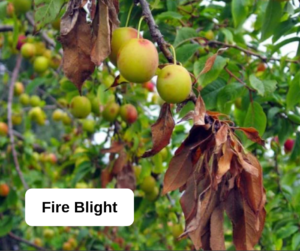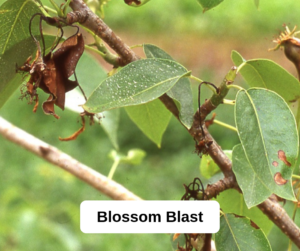Evaluation of Bactericide Programs for the Management of Fire Blight on ‘Idared’ Apples in New York, 2021.
A research trial was conducted at Cornell AgriTech in Geneva, NY to evaluate the effectiveness of bactericide programs for the management of blossom blight and shoot blight on apple. The orchard site is a planting of 18-yr-old ‘Idared’ trees on B.9 rootstocks. Treatments were applied using a gas-powered backpack sprayer calibrated to deliver 100 gal/A (0.5 gal/tree) at the following timings:
- Start: Silver Tip (April 10)
- Application 1: “Tight Cluster” (April 24)
- Application 2: “Full Pink” (April 27)
- Application 3: 20% Bloom (May 2)
- Application 4: 40% Bloom (May 4)
- Application 5: 80% Bloom (May 6)
- Application 6: Full Bloom/Early Petal Fall (May 8)
- Application 7: Full Petal Fall/Early Terminal Shoot Growth (May 11)
- Application 8: Active Terminal Shoot Growth (May 17)
Magna-Bon CS 2005 was included in two separate evaluations including:
- Incidence of Blossom Bight
1. With a 75% infection rate of Blossom Blight, CS 2005 had 83% control with the following protocol:
-
- Silver Tip: 48 ounces of CS 2005
- Applications 3 through 8: 16 ounces of CS 2005
2. With a 75% infection rate of Blossom Blight, CS 2005 mixed with Firewall and Regulaid had 100% control with the following protocol:
-
- Silver Tip: 48 oz CS 2005
- Applications 3, 5 and 7: 8 oz of CS 2005 + FireWall 17 (24 oz) + Regulaid 48 fl oz
- (4) Applications: Start at Silver Tip, 20% Bloom, 80% Bloom and Full Petal Fall/Early Terminal Shoot Growth
- Incidence of Shoot Blight
1.With a 60% infection rate of Shoot Blight, CS 2005 had 83% control with the following protocol:
-
- Silver Tip: 48 ounces of CS 2005
- Applications 3 through 8: 16 ounces of CS 2005
2. With a 60% infection rate of Shoot Blight, CS 2005 mixed with Firewall and Regulaid had 100% control with the following protocol:
-
- Silver Tip: 48 oz CS 2005
- Applications 3, 5 and 7: 8 oz of CS 2005 + FireWall 17 (24 oz) + Regulaid 48 fl oz
- (4) Applications: Start at Silver Tip, 20% Bloom, 80% Bloom and Full Petal Fall/Early Terminal Shoot Growth
Click Here to Download the Fire Blight Information Sheet.
 Applications of systemic acquired resistance inducers (SAR) were made both prior to and during terminal elongation to manage shoot blight. Bloom began on 28 Apr and trees progressed from 40% bloom (4 May) to full bloom/petal fall (8 May) with daily temperature averages ranging from 43°F to 63°F. Trees were inoculated at 80 to 90% bloom (7 May) with Erwinia amylovora strain Ea 273 at 1×106 CFU ml-1 using a hand-pumped Solo backpack sprayer. Blossom blight and shoot blight symptoms were assessed on blossom clusters and terminal shoots on 17 Jun, respectively. The incidence of blossom blight was expressed as the number of blighted blossom clusters out of five clusters with 20 cluster assessments for four replicate trees per treatment. Shoot blight was assessed as the percentage of terminal shoots with discoloration or ooze out of the total number of shoots for four replicate trees. The incidence of chemical injury in the form of russeting on fruit was calculated from the number of fruit with russeting out of five randomly collected fruit. Ten fruit collections were evaluated for each of four treatment replications. Disease incidence and chemical injury data were subjected to analysis of variance (ANOVA) for a randomized block design using accepted statistical procedures and software (i.e. Generalized Linear Mixed Models (GLIMMIX) procedure of SAS (version 9.4; SAS Institute Inc., Cary, NC). All percentage data were subjected to arcsine square root transformation prior to analysis.
Applications of systemic acquired resistance inducers (SAR) were made both prior to and during terminal elongation to manage shoot blight. Bloom began on 28 Apr and trees progressed from 40% bloom (4 May) to full bloom/petal fall (8 May) with daily temperature averages ranging from 43°F to 63°F. Trees were inoculated at 80 to 90% bloom (7 May) with Erwinia amylovora strain Ea 273 at 1×106 CFU ml-1 using a hand-pumped Solo backpack sprayer. Blossom blight and shoot blight symptoms were assessed on blossom clusters and terminal shoots on 17 Jun, respectively. The incidence of blossom blight was expressed as the number of blighted blossom clusters out of five clusters with 20 cluster assessments for four replicate trees per treatment. Shoot blight was assessed as the percentage of terminal shoots with discoloration or ooze out of the total number of shoots for four replicate trees. The incidence of chemical injury in the form of russeting on fruit was calculated from the number of fruit with russeting out of five randomly collected fruit. Ten fruit collections were evaluated for each of four treatment replications. Disease incidence and chemical injury data were subjected to analysis of variance (ANOVA) for a randomized block design using accepted statistical procedures and software (i.e. Generalized Linear Mixed Models (GLIMMIX) procedure of SAS (version 9.4; SAS Institute Inc., Cary, NC). All percentage data were subjected to arcsine square root transformation prior to analysis.
 The incidence of blighted blossom clusters ranged from 0-75%, and the incidence of blighted shoots ranged from 1-60% in all treatments. While fire blight pressure was lower in 2021 than, 2021, 2019 and 2018 due to cooler bloom time temperatures, most treatment programs still resulted in less than 30% incidence of blossom blight. All programs provided still more than 67% control of blossom blight. Interestingly, the complex organic programs (trt 23 and 24) consisting of blossom protect was less effective than expected. Similar trends were observed for the incidence of shoot blight, which developed from blossom blight infections. None of the fire blight management programs resulted in any fruit finish damage in the form of russeting.
The incidence of blighted blossom clusters ranged from 0-75%, and the incidence of blighted shoots ranged from 1-60% in all treatments. While fire blight pressure was lower in 2021 than, 2021, 2019 and 2018 due to cooler bloom time temperatures, most treatment programs still resulted in less than 30% incidence of blossom blight. All programs provided still more than 67% control of blossom blight. Interestingly, the complex organic programs (trt 23 and 24) consisting of blossom protect was less effective than expected. Similar trends were observed for the incidence of shoot blight, which developed from blossom blight infections. None of the fire blight management programs resulted in any fruit finish damage in the form of russeting.

